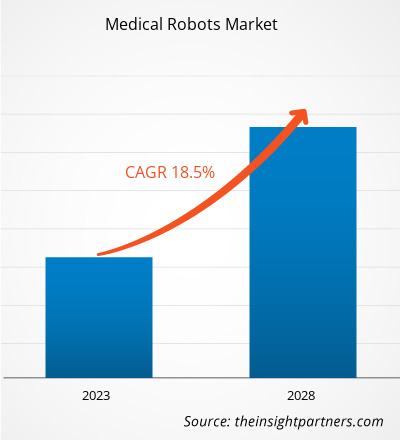医療用ロボット市場は、2022年の推定値91億8,970万米ドルから2028年には254億4,336万米ドルに達すると予測されており、2022年から2028年にかけて18.5%のCAGRで成長すると見込まれています。
外科手術件数の増加と製品の発売および承認件数の増加が、医療用ロボット市場を牽引すると予想されています。しかし、外科手術と設置にかかる高額な費用が市場の成長を阻害しています。
医療用ロボットは、特殊な医療用途向けに設計されています。これらのロボットは、手術、医療検査、患者のモニタリングなど、さまざまな医療タスクを実行できます。外科医の術前計画に基づいてのみ手術を実行できます。医療用ロボットにより、開腹手術や低侵襲手術で高精度な手術が可能になります。また、手術に必要な時間も大幅に短縮されます。さらに、医療用ロボットは、病院内のある場所から別の場所へ患者を搬送するために使用できます。遠隔介護用ロボット、院内感染を減らすための消毒ロボット、外部からのサポートと筋力トレーニングを提供するリハビリテーション訓練用ロボット外骨格などは、すべて医療用ロボットの応用例です。医療におけるロボット技術が初めて使用されたのは1985年ですが、ダヴィンチロボットが外科手術を行うために米国FDAの承認を取得したのは2000年になってからでした。ダヴィンチロボットは、心臓手術、頭頸部手術、泌尿器科手術での応用で広く知られています。
北米は、予測期間中、医療用ロボット市場を支配する可能性が高いです。米国は2022年に北米市場で最大のシェアを占め、この傾向は予測期間中も続くと予想されます。米国代謝・肥満外科学会が2022年に発表した調査によると、米国では過去10年間に肥満手術が約62.0%増加しました。さらに、米国医療研究品質庁(ACH)が2017年に発表した調査によると、米国では年間約70万件の膝関節全置換手術が行われています。このような膨大な数の手術は、予測期間中に米国の医療用ロボット市場を牽引する高度な医療施設の導入に好ましい環境を提供すると推定されます。
要件に合わせてレポートをカスタマイズ
レポートの一部、国レベルの分析、Excelデータパックなどを含め、スタートアップ&大学向けに特別オファーや割引もご利用いただけます(無償)
医療ロボット市場: 戦略的洞察

-
このレポートの主要な市場動向を入手してください。この無料サンプルには、市場動向から見積もりや予測に至るまでのデータ分析が含まれます。
医療用ロボット市場は、製品、用途、エンドユーザー、および地域に基づいてセグメント化されています。地域別に見ると、市場は北米、ヨーロッパ、アジア太平洋、中東およびアフリカ、南米および中米に大まかに分割されています。医療用ロボットレポートは、市場動向、技術の進歩、市場ダイナミクス、世界をリードする市場プレーヤーの競合分析などのパラメータに重点を置いて、市場の洞察と詳細な分析を提供します。
市場洞察
多数の外科手術世界中で手術件数が増加しています。過去25年間で、ヨーロッパ諸国では心血管疾患の発生率が増加しています。この地域では、糖尿病患者の増加とライフスタイルの変化により、心血管手術と一般手術の件数が増加しています。
がんと糖尿病は、世界的に死亡の主な原因の1つです。アメリカ癌協会(ACS)の調査によると、2021年に米国で約190万人の新たな癌症例が診断されました。オランダ癌登録によると、2021年にはオランダで約123,672人の新たな癌症例が登録されました。さらに、国際糖尿病連合(IDF)によると、2021年には世界中で推定5億3,700万人が糖尿病を患っており、その数は2045年までに7億8,300万人に達すると予想されています。
米国代謝・肥満外科学会が発表した調査によると、2019年には米国で約25万2,000件の減量手術が行われました。外科手術件数の増加により、ロボット手術器具の必要性が高まっています。したがって、慢性疾患の驚くべき蔓延と外科手術の数の増加は、ロボット手術器具の需要を生み出しています。
製品インサイト
製品に基づいて、世界の医療用ロボット市場は、外科用ロボット、リハビリテーション用ロボット、非侵襲性放射線手術用ロボット、病院および薬局用ロボット、その他に分類されます。外科用ロボットは、神経外科用ロボットシステム、心臓外科用ロボットシステム、腹腔鏡手術用ロボットシステム、および整形外科用ロボットシステムに細分化されます。2022年には、外科用ロボットセグメントが市場で最大のシェアを占めました。ロボット手術は、ロボット手術システムを使用して行われる外科手術です。外科用ロボットは、外科器具の位置決めと操作を支援するようにプログラムされた自己自動化されたコンピューター制御の医療機器であり、外科医が複雑な外科手術を行うのに役立ちます。これらのロボットは、開腹手術を行う外科医の能力を高める能力を持っています。したがって、外科用ロボットは、低侵襲的な方法により、より精度の高い複雑で高度な外科手術を行うことができます。ただし、リハビリテーション ロボット セグメントは、予測期間中に最高の CAGR を記録すると予想されます。
アプリケーション インサイト
アプリケーションに基づいて、世界の医療用ロボット市場は、腹腔鏡検査、神経学、整形外科、婦人科、泌尿器科、心臓学、その他に分類されます。2022 年には、腹腔鏡検査セグメントが市場で最大のシェアを占めました。ただし、神経学セグメントは、予測期間中に最高の CAGR を記録すると予想されます。腹腔鏡検査は、腹部内の臓器を検査するために使用される外科的診断手順です。ロボット手術は、小さな切開のみを必要とし、リスクが低い低侵襲手術です。2000 年、da Vinci 手術システムは、一般的な腹腔鏡手術用に FDA に承認された最初のロボット手術システムになりました。そして、最新のハイエンド モデルは da Vinci Xi です。医療用ロボットの導入により、腹腔鏡下外科手術の効率が向上しました。2022年1月には、ロボットが人間の手を借りずに豚の軟部組織に腹腔鏡手術を実施しました。医療分野が手術に腹腔鏡を用いるアプローチに移行するにつれて、そのような手術を支援するために設計された自動化ロボットシステムが重要になります。近年、腹腔鏡手術が好まれるようになった主な理由の1つは、医療分野が徐々に開腹手術から離れつつあることです。上記のすべての要因により、腹腔鏡手術市場は今後数年間で成長すると予想されます。
エンドユーザーの洞察
エンドユーザーに基づいて、世界の医療用ロボット市場は、病院、外来手術センター、その他に分類されます。2022年には、病院セグメントが市場で最大のシェアを占めました。さらに、医療上の利点と外科手術における医療ロボットの利用率の増加、そして外科手術中のロボットの性能向上により、同セグメントは予測期間中に市場で最も高いCAGRを記録すると予想されています。
世界の医療ロボット市場において、製品の発売と提携は、世界的な事業展開と製品ポートフォリオの拡大を図る上で、多くの企業が積極的に採用している戦略です。また、顧客基盤の拡大を目的としたパートナーシップ戦略にも注力しており、これにより世界的なブランドイメージの維持が可能になっています。革新的な製品の開発を通じて、市場シェアの拡大を目指しています。最近の主要な市場動向のいくつかを以下に示します。
- 2022 年 2 月、病院、長期ケア、薬局小売プロバイダー向けのヘルスケア提供ソリューションの大手イノベーターである Capsa Healthcare は、ニューヨーク市に拠点を置く柔軟なテクノロジー ソリューションとコンピューティング ワークステーションの設計および製造業者である Humanscale Healthcare を買収しました。
- 2022 年 1 月、Omnicell, Inc. は、患者の安全、正確性、コスト削減、サプライ チェーン管理、コンプライアンス上のメリットを提供しながら、業界の問題に正面から取り組む完全自動 IV 調剤ロボットである Reimaging IV Station を発売しました。
- 2021 年 10 月、Accuray は Precision Treatment Planning System を発売しました。これにより、ユーザーは簡単に計画を立て、品質を最適化し、効率的に治療を行うことができます。VOLO Ultra は、計画ソリューションである Accuray Precision Treatment Planning System の最新進化形です。最新の高速勾配ベースアルゴリズムを備えた最先端のオプティマイザーが搭載されており、あらゆる治療に最適な計画品質を提供します。
- 2021 年 6 月、ARxium はリール大学病院に注射用化学療法の準備のためのロボット「RIVA」を導入しました。
医療用ロボット市場の地域別分析
The Insight Partnersのアナリストは、予測期間を通じて医療ロボット市場に影響を与える地域的な動向と要因を詳細に解説しています。このセクションでは、北米、ヨーロッパ、アジア太平洋、中東・アフリカ、中南米における医療ロボット市場のセグメントと地域についても解説しています。
医療用ロボット市場レポートの範囲
| レポート属性 | 詳細 |
|---|---|
| の市場規模 2022 | US$ 9.19 Billion |
| 市場規模別 2028 | US$ 25.44 Billion |
| 世界的なCAGR (2022 - 2028) | 18.5% |
| 過去データ | 2020-2021 |
| 予測期間 | 2023-2028 |
| 対象セグメント |
By 製品
|
| 対象地域と国 |
北米
|
| 市場リーダーと主要企業の概要 |
|
医療用ロボット市場におけるプレーヤーの密度:ビジネスダイナミクスへの影響を理解する
医療用ロボット市場は、消費者の嗜好の変化、技術の進歩、製品の利点に対する認知度の高まりといった要因により、エンドユーザーの需要が高まり、急速に成長しています。需要が高まるにつれ、企業は製品ラインナップの拡充、消費者ニーズへの対応、そして新たなトレンドの活用を進めており、これが市場の成長をさらに加速させています。

- 入手 医療ロボット市場 主要プレーヤーの概要
医療用ロボット - 市場セグメンテーション
世界の医療用ロボット市場は、製品、用途、エンドユーザーに基づいてセグメント化されています。製品別に見ると、世界の医療用ロボット市場は、外科用ロボット、リハビリテーション用ロボット、非侵襲性放射線手術用ロボット、病院・薬局用ロボット、その他に分類されています。用途別に見ると、世界の医療用ロボット市場は、腹腔鏡検査、神経学、整形外科、婦人科、泌尿器科、心臓病学、その他に分類されています。エンドユーザーの観点から見ると、医療用ロボット市場は病院、外来手術センター、その他に分類されます。
企業プロファイル
- Intuitive Surgical, Inc.
- Stryker Corporation
- Hocoma AG
- Medtronic
- Auris Health, Inc.
- Accuray Incorporated
- Omnicell Inc.
- Arxium
- Ekso Bionics Holdings, Inc.
- Kirby Lester LLC.
- 過去2年間の分析、基準年、CAGRによる予測(7年間)
- PEST分析とSWOT分析
- 市場規模価値/数量 - 世界、地域、国
- 業界と競争環境
- Excel データセット
最新レポート
関連レポート
お客様の声
購入理由
- 情報に基づいた意思決定
- 市場動向の理解
- 競合分析
- 顧客インサイト
- 市場予測
- リスク軽減
- 戦略計画
- 投資の正当性
- 新興市場の特定
- マーケティング戦略の強化
- 業務効率の向上
- 規制動向への対応






















 無料サンプルを入手 - 医療ロボット市場
無料サンプルを入手 - 医療ロボット市場